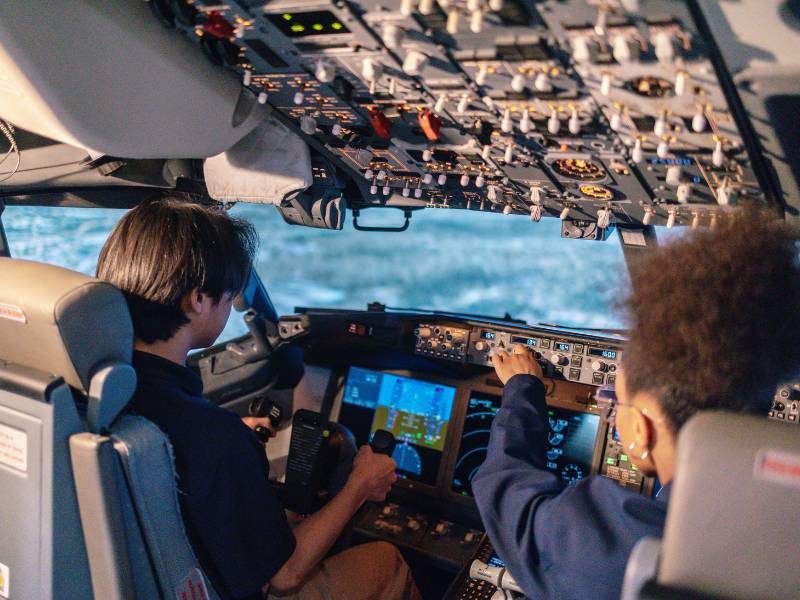At Rising Aviation, we want to give students with a passion for flying a leg up on a career in the cockpit. Our approach is to make it possible for students to go from high school to airline captain with a proven pathway.
A career as an airline pilot is a great option for students interested in aviation. Recent analyses have shown there will be increasing demand for qualified pilots in the future, so both the job outlook, and money-making potential are very good.
Not everyone who goes to work has an office traveling at 35,000 feet and 500 mph. If you ask, most pilots will tell you they’ve ‘never worked a day in their lives.’
While that’s not exactly true—becoming a professional pilot takes a lot of hard work and dedication—it is certainly one of the most fun career choices we can imagine.
Here are the exact staps you can take to go from high school student to airline pilot.
Step 1: Rising Aviation High School and Private Pilot License
As a private high school student at Rising Aviation High School, you’ll have the opportunity to pursue your flight training while in high school. Prep for your private pilot license is built into your school work.
You’ll prepare for and take your private pilot ground exam. During your junior year you’ll start to fly with Thrust Flight right here at Addison Airport.
Thrust Flight is a leading flight school in the Dallas area and a partner with Rising Aviation.
During your junior or senior year of high school you’ll complete all of your private pilot training and pass your checkride to officially earn your private pilot certificate.
Upon graduating from Rising Aviation, you’ll be prepared to take the next step and complete all of your additional certificates and ratings to qualify to become an airline pilot.

Step 2: Advanced Flight Training with Thrust Flight
After graduating from Rising Aviation High School you can immediately enroll in Thrust Flight’s Zero Time to Airline program starting at the instrument level.
The Instrument Rating allows you to fly in poor visibility and through the clouds. After that, you’ll work on your Commercial Pilot certificate and Multi-Engine Ratings. You’ll also earn your Certified Flight Instructor and CFI Instrument ratings to allow you to work as a flight instructor.
At this point in your flight training, you’ll have accumulated between 200 and 300 hours.
Step 3: Flight Instructing to Build Flight Time
The Commercial Pilot license allows you to earn a living as a pilot, but airlines require you to have at least 1,500 flight hours (in most cases) before you can apply for a job as a first officer.
Getting to this point is called “time building,” so the goal of the aspiring airline pilot is to find a job that pays them to fly while building up hours in their logbook.
The number one job for that purpose is to work as a Certified Flight Instructor (CFI).
You can build up the necessary time in your logbook in about two years, all while becoming well-versed in aviation. Airlines love hiring flight instructors because successful flight instructors really know their stuff.

You can easily complete your flight training while attending college.
There are aviation colleges you might consider, or continue flying with a provider like Thrust Flight and go to school anywhere you like. Most airlines prefer applicants who have a four-year college degree, but it isn’t a requirement at this time.
If you’re eyeing a career at a particular airline, it pays to research that company’s pathway program. Most airlines have partner flight schools—in some cases universities— where students can follow a particular curriculum toward a career at that airline.
Each program is different, so research carefully.
Step 4: First Officer at a Regional Airline
To work for a regional airline, you must possess an Airline Transport Pilot (ATP) certificate.
As mentioned earlier, the ATP requires 1,500 hours of flight time and being at least 23 years old. Although you can begin working as an airline pilot with a Restricted ATP at 21.
Once you’ve reached this point, you can apply to the airlines as a copilot.
Pilots start their careers working at smaller regional airlines. These companies operate smaller planes and often have agreements with the bigger airlines.
You might know them by names like Delta Connection, American Eagle, and United Express.
However, they’re usually run by separate companies. Some examples include SkyWest, Envoy, Endeavor Air, Republic, Mesa, and PSA.
There are many regional airline jobs all over the world. It’s also worth noting that not all professional pilots decide to fly for the airlines.
Many opt for the corporate aviation world instead, flying business jets for charter or private companies. These jobs have a variety of experience requirements depending on the company.

Step 5: A Career with a Major Airline
After three to five years of working at a regional airline, most pilots will have enough flight time and turbine time to apply to the major airlines. The major carriers are those who fly the biggest planes and pay their pilots the best salaries.
The “Big 4” major US airlines include United, American, Delta, and Southwest. Other large airlines that offer great benefits to their pilots include JetBlue, Spirit, Alaska, Hawaiian, and Frontier.
Of course, these are just the big names and those in the US. Worldwide, there is a growing demand for pilots everywhere.
Flying freight is another great career choice, with major carriers including FedEx, UPS, and Atlas.
And there you have it—from high school to professional airline pilot in five steps.
The steps aren’t easy, and each one has unique challenges and will take time.
But the goals are achievable with a flight plan in front of you that are obtainable with the winning combination of Rising Aviation High School and Thrust Flight at Addison Airport!





